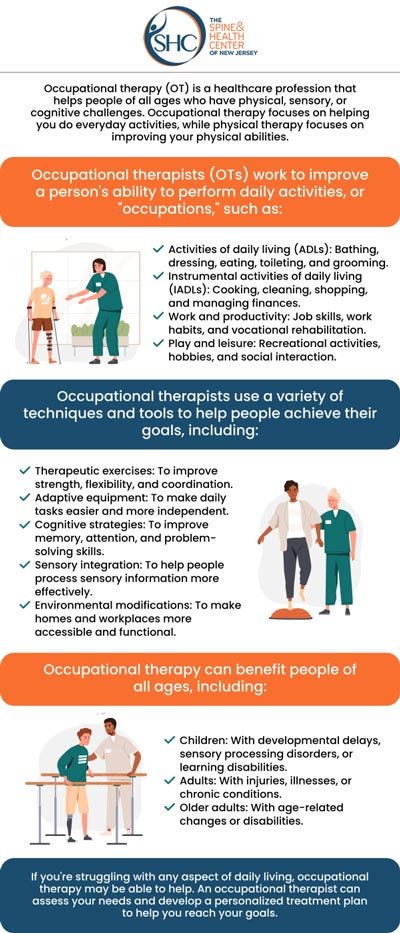Occupational vs. Physical Therapy_ Patient Questions

Occupational vs. Physical Therapy: Understanding the Differences
What Is the Difference Between Occupational and Physical Therapy?
Occupational therapists (OTs) and physical therapists (PTs) both help people recover from illness, injury, or disability—but they do so in different ways. OTs focus on improving a person’s ability to perform daily tasks, while PTs work on restoring movement, strength, and overall physical function.
Conditions Treated by Occupational and Physical Therapists
OTs and PTs work with people of all ages facing a variety of medical challenges, including:
-
Neurological disorders such as stroke, Parkinson’s disease, spinal cord injuries, and traumatic brain injuries
-
Orthopedic conditions like fractures, arthritis, tendonitis, and joint replacement
-
Genetic or developmental conditions such as Down syndrome, Huntington’s disease, and Marfan syndrome
You’ll find these professionals in hospitals, outpatient clinics, nursing homes, rehabilitation centers, and schools. OTs may also work in mental health facilities, while PTs often specialize in fitness or sports rehab settings.
What Does an Occupational Therapist Do?
Roles and Responsibilities of an Occupational Therapist
An occupational therapist helps people perform everyday tasks more independently and safely, with a focus on restoring meaning and purpose in their lives. Their work covers:
-
Basic daily activities (ADLs): bathing, dressing, and eating
-
Instrumental daily activities (IADLs): managing money, cooking, shopping
-
Health management and personal care
-
Education, work, play, and social participation
Types of Occupational Therapy Interventions
OTs use a variety of tools and strategies to support physical, mental, and cognitive function, including:
-
Range of motion and strengthening exercises
-
Splints and adaptive devices (e.g., raised toilet seats, bath benches)
-
Life skills training (e.g., budgeting, grooming, cooking)
-
Cognitive rehabilitation and stress management techniques
-
Assistive technology and wheelchair fitting
What Does a Physical Therapist Do?
Roles and Responsibilities of a Physical Therapist
Physical therapists are movement specialists who help people improve their mobility, reduce pain, and regain physical function after injury or illness. Their approach includes:
-
Designing personalized exercise programs
-
Teaching proper movement patterns
-
Preventing further injuries through education
Types of Physical Therapy Interventions
PTs use hands-on techniques and therapeutic tools such as:
-
Stretching and strengthening exercises
-
Manual therapy (massage, joint mobilization)
-
Heat and cold therapies, ultrasound, electrical stimulation
-
Balance training and gait analysis
-
Use of mobility aids (e.g., walkers, crutches, canes)
-
Braces and wound care
Choosing Between Occupational Therapy and Physical Therapy
Is One Better Than the Other?
There’s no clear “winner” between OT and PT—both are essential depending on the individual’s needs. In many cases, patients benefit from both therapies simultaneously. Here’s a guide to help you decide:
OT Might Be Right for You If You’re Interested In:
-
Helping people perform daily routines more independently
-
Creating safer and more functional living environments
-
Working with clients who have cognitive or developmental disabilities
-
Supporting patients with eating or self-care challenges
-
Addressing mental health concerns through daily structure
PT Might Be Right for You If You’re Interested In:
-
Assisting patients with mobility, walking, and movement after injury
-
Working in sports rehab or with injured athletes
-
Specializing in cardiac or pulmonary rehabilitation
-
Helping patients with pelvic health or wound care
If you’re unsure, consider job shadowing professionals in both fields and asking questions about their daily work.
Education and Specializations
How to Become an Occupational Therapist
To become a licensed OT, you must complete:
-
A master’s or doctoral degree in occupational therapy from an accredited program
-
The National Board for Certification in Occupational Therapy (NBCOT) exam
-
State licensure
OT Specialty Certifications Include:
-
Driving and community mobility
-
Environmental modification
-
Feeding, eating, and swallowing
-
Low vision therapy
-
School-based practice
-
Hand therapy (through the Hand Therapy Certification Commission)
How to Become a Physical Therapist
To become a licensed PT, you need to:
-
Earn a Doctor of Physical Therapy (DPT) degree (typically 3 years post-bachelor’s)
-
Pass the National Physical Therapy Examination (NPTE)
-
Get state licensure
PT Specialty Certifications (offered by the American Board of Physical Therapy Specialties):
-
Cardiovascular and pulmonary rehabilitation
-
Clinical electrophysiology
-
Geriatrics
-
Neurology
-
Oncology
-
Orthopedics
-
Pediatrics
-
Sports physical therapy
-
Women’s health
-
Wound management
Frequently Asked Questions
Do You Need a Referral to See a Therapist?
In many states, patients can see an OT or PT without a referral—this is called direct access. However, check with your state laws and insurance provider, as some plans still require referrals from a doctor, nurse practitioner, or physician assistant.
Who Earns More: OT or PT?
According to the U.S. Bureau of Labor Statistics (2021 data):
-
Median salary for occupational therapists: $85,570
-
Median salary for physical therapists: $95,620
Earnings can vary based on experience, geographic location, and work setting.
Who Spends More Time in School?
Both OTs and PTs must attend graduate school, but:
-
OTs can enter the field with a master’s degree (minimum requirement) or a doctorate
-
PTs are required to complete a doctorate (DPT), which typically takes longer
Why Is PT More Commonly Recommended Than OT?
While both fields are essential, PT often receives more public attention—especially through sports rehabilitation or recovery stories involving athletes. This can make it seem more common, though both therapies are equally important depending on the patient’s condition.






